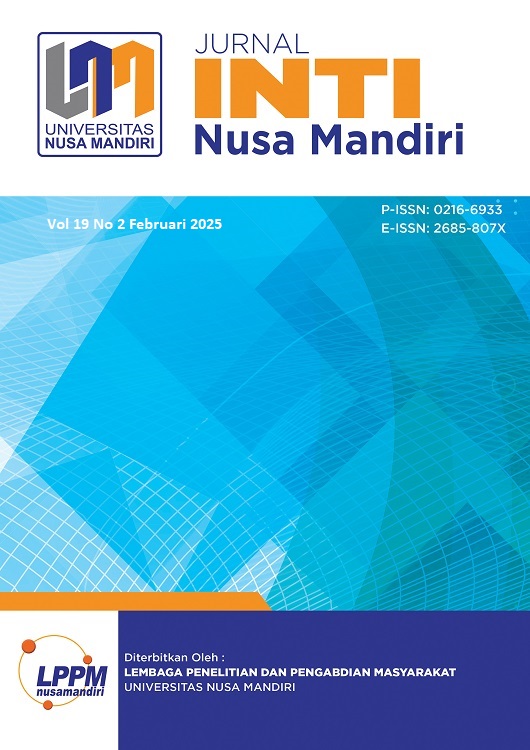SISTEM DETEKSI GEMPA BERBASIS IOT DENGAN VISUALISASI REAL-TIME DAN NOTIFIKASI CERDAS
DOI:
https://doi.org/10.33480/inti.v19i2.6394Keywords:
accel magnitudo, broadcast, gyro magnitudo, ThingSpeak, wokwi simulatorAbstract
Indonesia, as a region with high seismic activity, requires a fast, accurate, and reliable disaster mitigation system. However, most existing earthquake detection systems still focus primarily on data collection without automatic notifications, which delays response times in emergency situations. This study develops an Internet of Things (IoT)-based early earthquake detection system that integrates a gyroscope sensor, the ThingSpeak cloud platform, and an Android application to provide real-time information to users. The system detects orientation changes along the X, Y, and Z axes, calculates vibration magnitude through a calibrated algorithm, and sends automatic notifications via WhatsApp to mitigation officers. Testing was conducted through simulations using Wokwi to validate the algorithm and physical implementation in real-world conditions, demonstrating that the system achieves high accuracy in detecting seismic activity, with an average accelerometer magnitude of 3.35 and a gyroscope magnitude of 4.19. Data visualization on ThingSpeak, along with graphical displays in the Android application, enables intuitive and real-time earthquake monitoring. The integration of smart notifications via WhatsApp ensures a fast response from mitigation officers, making it an effective and applicable solution for earthquake risk mitigation.
Downloads
References
Adhikary, A., Halder, S., Bose, R., Panja, S., Halder, S., Pratihar, J., & Dey, A. (2024). Design and Implementation of an IOT-based Smart Home Automation System in Real World Scenario. EAI Endorsed Transactions on Internet of Things, 10. https://doi.org/10.4108/eetiot.6201
Arifien, Z., Bachtiar, F. A., & Yudistira, N. (2022). Pengenalan Aktivitas Manusia Menggunakan Sensor Akselerometer dan Giroskop pada Smartphone dengan Metode K-Nearest Neighbor. Jurnal Teknologi Informasi Dan Ilmu Komputer (JTIIK), 9(1), 173–180. https://doi.org/10.25126/jtiik.2022915593
Bengi, N. S., Syamsul, S., & Nasri, N. (2024). Prototype sistem pendeteksi gempa bumi dan peringatan dini berbasis Internet of Things. Jurnal TEKTRO, 8(1). https://doi.org/10.30811/tektro.v8i1.5682
(BNPB), B. N. P. B. (2021). Laporan Tahunan BNPB 2021. https://bnpb.go.id
Chakraborty, S., & Aithal, P. S. (2024). WhatsApp-Based Notification on Low Battery Water Level Using ESP Module and TextMeBOT. International Journal of Case Studies in Business, IT, and Education, 8(1). https://doi.org/10.5281/zenodo.10835097
Chebanyuk, O., & Yukhymenko, A. (2021). Approach to prevent of spoken information leakage through gyroscope and accelerometer sensors in mobile devices with Android operation system. Information Theories and Applications, 28(3), 219–232. https://doi.org/10.54521/ijita28-03-p02
Effendi, R., Kania, R., & Muhammad, M. (2023). Prototype Sistem Pendeteksi Gempa Bumi dan Peringatan Dini Berbasis Internet of Things. E-Jurnal Politeknik Negeri Lhokseumawe.
Elyana, Ega, & Marom, A. (2023). SIGEMPA: Sistem Peringatan Dini Gempa Bumi berbasis IoT dengan ESP32. ResearchGate.
Jan, F., Min-Allah, N., & D"uşteg"or, D. (2021). IoT Based Smart Water Quality Monitoring: Recent Techniques, Trends and Challenges for Domestic Applications. Water, 13(13), 1729. https://doi.org/10.3390/w13131729
MathWorks. (2023). ThingSpeak IoT Platform Documentation. https://www.mathworks.com/help/thingspeak/
Nurhadi, N., Akasse, H., & Jemy, U. (2021). Analisis dampak ekonomi akibat bencana alam gempa bumi, tsunami, dan likuifaksi di Kota Palu. Jurnal Kolaboratif Sains, 4(11). https://doi.org/10.56338/jks.v4i11.1983
Olanubi, O. O., Akano, T. T., & Asaolu, O. S. (2024). Design and development of an IoT-based intelligent water quality management system for aquaculture. Journal of Electrical Systems and Information Technology, 11, Article 15. https://doi.org/10.1186/s43067-024-00139-z
Siregar, A. B., Ezwarsyah, Yusdartono, H. M., & Nasution, F. A. (2022). Rancang bangun sistem peringatan gempa menggunakan sensor ADXL 345 berbasis LoRa dengan ESP 32. Jurnal Energi Elektrik, 11(2), 8–14. https://e-jurnal.pnl.ac.id/TEKTRO/article/view/5682
Tisnadinata, M. A., Suwastika, N. A., & Yasirandi, R. (2023). Sistem Peringatan Dini Gempa Bumi Multi Node Sensor Berbasis Fuzzy dan Komunikasi IoT. SOCJS Telkom University.
U. V. Author, W. X. A. (2024). Implementation of IoT-Based Monitoring System for Industrial Equipment Using Android App and WhatsApp Notifications. International Journal of Industrial Electronics and Control, 10(2). https://doi.org/10.1016/j.ijiec.2024.02.005
Widagdo, M. L. A., & Timur, M. I. A. (2023). Peningkatan Akurasi Deteksi Jatuh Menggunakan Sensor Akselerometer dan Giroskop pada Smartphone. Indonesian Journal of Electronics and Instrumentation Systems, 8(1), 1–5. https://jurnal.ugm.ac.id/ijeis/article/view/93068/39103
Wikantama, P. T., Bahalwan, M., & Akmal, M. A. G. (2024). SIGEMPA: Sistem Peringatan Dini Gempa Bumi berbasis IoT dengan ESP32. Jurnal Teknik Mesin, Elektro Dan Ilmu Komputer, 4(1), 63–70. https://doi.org/10.55606/teknik.v4i1.2937
Williamsyah, B. M., Rizal, A., Wijaya, R., & Ziani, S. (2024). Heart rate measuring system using accelerometer and gyroscope sensor in Android smartphone. Proceedings of the 2024 4th International Conference on Electrical, Computer, Communications and Mechatronics Engineering (ICECCME). https://doi.org/10.1109/ICECCME58375.2024.10748185
Wokwi Documentation. (2023). Introduction to Wokwi Simulator. https://docs.wokwi.com/
Downloads
Published
How to Cite
Issue
Section
License
Copyright (c) 2025 Riadi Marta Dinata, Ariman Ariman, Muhammad Ikrar Yamin

This work is licensed under a Creative Commons Attribution-NonCommercial 4.0 International License.
Penulis yang menerbitkan jurnal ini menyetujui ketentuan berikut:
1. Penulis memegang hak cipta dan memberikan hak jurnal mengenai publikasi pertama dengan karya yang dilisensikan secara bersamaan di bawah Creative Commons Attribution 4.0 International License. yang memungkinkan orang lain untuk berbagi karya dengan pengakuan atas karya penulis dan publikasi awal pada jurnal.
2. Penulis dapat memasukkan pengaturan kontrak tambahan yang terpisah untuk distribusi non-eksklusif dari versi jurnal yang diterbitkan (misalnya, mengirimkannya ke repositori institusional atau menerbitkannya dalam sebuah buku), dengan pengakuan atas publikasi awalnya pada Jurnal.
3. Penulis diizinkan dan didorong untuk memposting karya mereka secara online (misalnya, dalam penyimpanan institusional atau di situs web mereka) sebelum dan selama proses pengiriman, karena hal itu dapat menghasilkan pertukaran yang produktif, serta kutipan dari karya yang diterbitkan sebelumnya.











